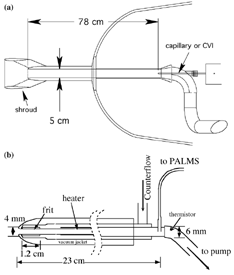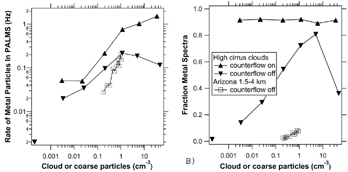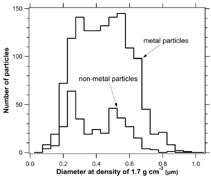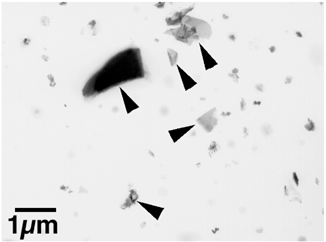Figures & data
TABLE 1 Length scales for spherical particles with density 0.9 g cm−3 at 190 m s−1 and 120 mbar
FIG. 1 Diagrams of the PALMS aircraft inlets. (a) Air was drawn into either the nose of the aircraft or wing pod through a 5 cm tube. The center of this flow was sampled either with a capillary or with a counterflow virtural impactor (CVI). (b) Detail of the CVI inlet.

FIG. 2 Sample mass spectra of single particles. (a) and (b) Negative and positive ion spectrum of particles using a counterflow virtual impactor in a cirrus cloud. These are inferred to be a stainless steel particle formed by collision of ice crystals with the inlet. (c) Metal particle produced in the laboratory by impact of an ice crystal on a stainless steel frit. (d) Positive ion spectrum of a particle with meteoric material. Despite the Fe, Cr, and Ni peaks in common with stainless steel the meteoric material is easily distinguished by, for example, sulfate, the large Mg peak, lack of Mo, and a specific Na/K ratio.

FIG. 3 The rate of metal particles observed by PALMS as a function of the concentration of large particles. The cirrus cloud curves are from the NASA WB-57. The cloud concentration is defined as the particles larger than 10 μ m measured by the CAPS probe (CitationBaumgardner et al. 2002). The Arizona curve is from the NOAA P3 outside of cloud (relative humidity less than 15%) for which the coarse-mode particles are those larger than 2.5 μ m measured by a Climet 105 counter. These coarse particles were dust and fly ash from power plant plumes. There were 10461 particles sampled with counterflow on in cloud, 2838 with counterflow off in cloud, and 5479 with counterflow off out of cloud (lower left point).

FIG. 4 Aerodynamic size distribution of particles measured in cirrus clouds with the counterflow active so that only ice crystals could enter the CVI inlet. The nonmetal particles are primarily residues of ice crystals. The lower size limit for detection by PALMS for these flights was about 0.12 μ m optical diameter with decreasing efficiency below about 0.2 μ m.

FIG. 5 Transmission electron microscope image of particles collected from clouds with the impactor sampler on the WB-57. Angular-to-irregularly-shaped particles (indicated by arrowheads) contain Zn and minor C and O.

FIG. 6 Mass spectra of particles in the Space Shuttle exhaust plume and in a cloud the next day. The latter particle was probably deposited in the inlet during the plume encounter and dislodged by an ice crystal.
